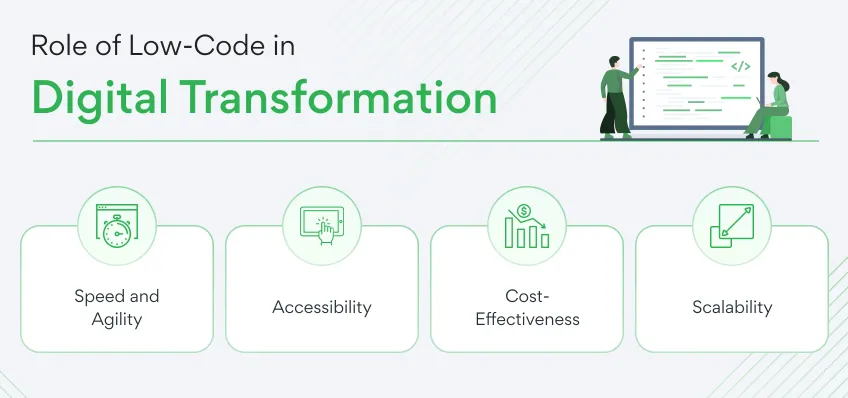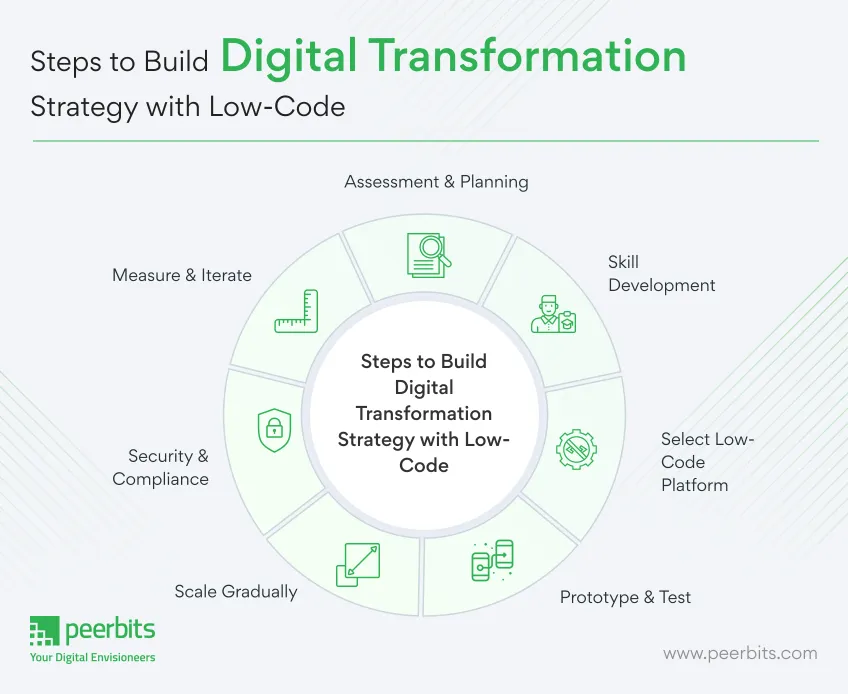Nowadays, staying ahead of the curve is not just an advantage; it's a necessity. The business world has witnessed a monumental shift in recent years, where digital transformation has become the lifeblood of thriving organizations. It's not merely about adopting new technologies; it's a comprehensive overhaul of how businesses operate, deliver value, and engage with customers and stakeholders.
At the forefront of this revolution is the low-code approach—a transformative force that is reshaping the way businesses embrace digital transformation.
This blog takes you on a journey into the heart of this "Low-Code Revolution" and explores how it can be harnessed to craft a future-ready digital transformation strategy. The fusion of low-code development with the principles of digital transformation is changing the rules of the game.
It's not just about building applications more quickly; it's about empowering organizations to thrive in an increasingly digital world, become more agile, customer-focused, and prepared for whatever the future holds. Let's delve into the intricacies of this transformational approach and how it can redefine the way we think about digital evolution.
Understanding Digital Transformation
Before we dive into the low-code revolution, let's first clarify what digital transformation entails. It's not merely about adopting new technologies; it's a comprehensive overhaul of how businesses operate, deliver value, and engage with customers and stakeholders. It involves integrating digital technologies into all aspects of an organization, fundamentally changing how it functions.
Digital transformation involves:
-
Customer-Centricity: Placing customers at the core of your strategy, understanding their needs, and delivering exceptional experiences.
-
Operational Efficiency: Streamlining processes, reducing manual work, and increasing productivity through automation and digitization.
-
Data-Driven Decision-Making: Leveraging data analytics and insights to make informed decisions and drive growth.
-
Innovation: Fostering a culture of innovation to adapt quickly to market changes and explore new business models.
The Role of Low-Code in Digital Transformation
Now, let's introduce the star of our blog: ‘low-code development.’ Low-code platforms enable organizations to build applications with minimal hand-coding. Instead of writing every line of code from scratch, developers can use visual interfaces and pre-built components to create applications faster and more efficiently. This approach is a game-changer for digital transformation, and here's why:

Speed and Agility
Low-code platforms accelerate the development process. Businesses can respond to changing market demands, customer feedback, and emerging opportunities much faster than with traditional development approaches.
Accessibility
Low-code empowers not only professional developers but also business analysts and domain experts to participate in application development. This democratization of development resources increases agility and innovation.
Cost-Effectiveness
Developing applications with low-code can significantly reduce app development costs. You need fewer developers, and development times are shorter, resulting in a more cost-efficient process.
Scalability
Low-code platforms are inherently scalable, allowing businesses to adapt and grow without the need for massive code rewrites or overhauls.

Building a Future-Ready Digital Transformation Strategy with Low-Code
Now that we understand the power of low-code in the digital transformation landscape, let's outline steps to build a future-ready digital transformation strategy with low-code:

Assessment and Planning
Start by assessing your current processes, identifying pain points, and setting clear digital transformation goals. Determine where low-code can have the most significant impact.
Skill Development
Invest in training and upskilling your team in low-code development. Encourage cross-functional collaboration between business experts and IT professionals.
Select the Right Low-Code Platform
Choose a low-code platform that aligns with your organization's needs, scalability requirements, and security standards.
Prototype and Test
Begin with small, manageable projects to prototype and test the low-code approach. Use this as an opportunity to gather feedback and refine your strategy.
Read more: Discover the common digital transformation challenges and solutions
Scale Gradually
As you gain confidence and expertise, scale your low-code initiatives across the organization. Focus on high-impact areas like customer engagement, process automation, and data analytics.
Security and Compliance
Ensure that your low-code applications meet security and compliance standards. Work closely with your IT and security teams to address any concerns.
Measure and Iterate
Continuously monitor the performance and impact of your low-code applications. Gather data and insights to refine your digital transformation strategy over time.
Read more: Find out what role does DevOps play in digital transformation
Digital transformation, as we've seen, goes far beyond the mere adoption of new technologies. It encompasses a fundamental shift in how organizations operate, deliver value, and engage with their stakeholders. In this context, low-code development emerges as a powerful enabler, offering agility, accessibility, cost-efficiency, and scalability.
As businesses embrace this transformative journey, they must assess their current processes, set clear goals, and foster a culture of innovation. By investing in the development skills of their teams, selecting the right low-code platform, and carefully testing and scaling their initiatives, organizations can craft a digital transformation strategy that propels them to the forefront of their industries.
Final Thought
The convergence of digital transformation services and low-code development is not just an evolution; it's a revolution. It's a revolution that empowers businesses to not only survive but thrive in the digital age, where change is the only constant. By leveraging low-code as a cornerstone of their digital transformation strategy, organizations can look forward to a future where they are nimble, customer-centric, and ready to seize every opportunity that comes their way.
The low-code revolution is not just about building applications more quickly; it's about empowering organizations to thrive in an increasingly digital world. By embracing low-code as a fundamental part of your digital transformation strategy, you can become more agile, customer-focused, and prepared for whatever the future holds.
It's time to join the revolution and build a future-ready organization by keeping an eye on the latest trends in digital transformation that can adapt and innovate with ease. So, don’t be left behind and get started with a digital transformation strategy with low code to enjoy the endless benefits for your business.









